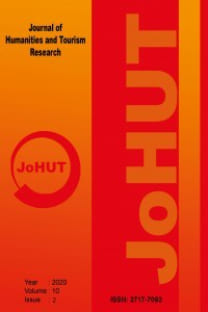Nogay Türklerinin Özel Günlerdeki Yeme İçme Alışkanlıkları
Toplum hayatında önemli geçiş dönemlerini anlamlandıran bazı ritüellerin yapıldığı günlere özel günler denir. Özel günlerde bir araya gelmekle ilişkiler güçlenir, birlik ve dayanışma duygusu artar. Bu bağlamda, özel günlerde yemeklere ve sunumlara özel önem verilmektedir. Nogay Türkleri tarih boyunca göçler yaşamış olsalar da kendi gelenek, göreneklerini ve dillerini koruyan bir Türk topluluğudur. Nogay Türklerinde özel günlerde yapılan yemeklerin yemekleri ve sunum şekilleri geçmişten günümüze kadar varlığını sürdürmüştür. Bu çalışmada Konya ili Kulu ilçesine bağlı Seyitahmetli, Ağılbaşı (Süt Çiftliği), Köstengil ve Kırkkuyu köylerinde Nogay Türklerinin yeme içme alışkanlıkları özel gün ve gecelere odaklanacaktır. Nitel bir araştırma yönteminin benimsendiği çalışma, bu köylerde yaşayan 21 Nogay Türkü ile gerçekleştirilmiştir. Çalışmada yarı yapılandırılmış görüşme formu kullanılmış ve kartopu örnekleme yöntemi kullanılarak örnek seçilmiştir. Elde edilen bulgular ışığında Nogay Türkleri özel günlere, kutsal günlere önem vermekte ve bu günlerde çeşitli yeme içme adetleri ve ritüelleri uygulamaktadırlar. Nogay Türklerinde özel günlerde yapılan yemekler bu yemeklerin hazırlanmasının ardındaki anlamlar maddi ve manevi kültürü bir arada tutmanın bir örneği olmakla birlikte aralık ayında kültürün izlerini de göstermektedir. Çalışma, bölgenin gıda mirasının ve ritüel geleneğinin korunması, tanıtılması ve gelecek nesillere aktarılması açısından çok önemlidir.
Eating and Drinking Customs of Nogai Turks on Special Days
The days when certain rituals are performed that make sense of important transition periods in the life of society are called as special occasions. On special days, relations are strengthened with getting together, and the feeling of unity and solidarity is increased. In this regard, special attention is paid to meals and presentations on special occasions. Although the Nogai Turks have experienced migrations throughout history, they are a Turkish community that maintains their own traditions, customs and languages. Dishes and forms of presentation of dishes made on special occasions in the Nogai Turks have existed from the past to the present day. In this study, the eating and drinking habits of Nogai Turks in the villages of Seyitahmetli, Ağılbaşı (Dairy Farm), Köstengil and Kırkkuyu in the Kulu district of Konya province will be focused on special days and nights. The study, in which a qualitative research method was adopted, was conducted with 21 Nogai Folk Songs living in these villages. In the study, a semi-structured interview form was used and the sample was selected using the snowball sampling method. In the light of the findings obtained, the Nogai Turks attach importance to special days, holy days and practice various eating and drinking customs and rituals on these days. Dishes made on special occasions in Nogai Turks The meanings behind the preparation of these dishes are an example of keeping material and spiritual culture together, but also show the traces of culture in the dec. The study is very important for the preservation, promotion and transfer of the food heritage and ritual tradition of the region to future generations.
___
- Akbaba, D. E. (2013). On the Name of Nogai and the Origin of Nogays, Journal of Endangered Languages, 2(2), 233-242.
- Akbaba, D. E. (2015). An Overview of the Nogai Turks. New Turkey. 313-319.
- Akbaba, D.E. and Benli, H. (2011) Postnatal Beliefs of Nogai Turks Living in Anatolia and the North Caucasus, Gazi Turkiyat, 1(9), 87-100.
- Alpargu, M. (2007). Nogais. Istanbul: Değişim Publications.
- Alyakut, O. (2020). The effect of mass culture on traditional Turkish dessert culture: New generation lokma dessert in internet media. Journal of Social and Humanities Sciences Research, 7 (51), 377-391.
- Atay, A., (1998). Nogai Turkish Grammar, Unpublished Doctoral Thesis, Kayseri: Erciyes University Institute of Social Sciences.
- Atik, E., Atik, E. (2020). Migrations in terms of Contribution to Turkish Culinary Culture: A Study on Thessaloniki Emigrants, Journal of Current Tourism Studies, 4(2): 261-277.
- Bondar, N., and Golikova, T. (2022). Culinary traditions and eating patterns of various Ukrainian regions. In Nutritional and Health Aspects of Traditional and Ethnic Foods of Eastern Europe (pp. 123-146). Academic Press.
- Beer, S., Edwards, J., Fernandes, C., Sampaio, F. (2002). Regional food cultures: integral to the rural tourism product? In: Hjalager, A.-M., Richards, G. (Eds.), Tourism and Gastronomy. Routledge, London, pp. 221–237.
- Benli, H. (2020). Nogay Turks Living in Turkey, Bandırma Real Newspaper, 23.03.2020. [Access address: https://www.gercekbandirma.com/turkiyede-yasayan-nogay-turklerihakan-benli] [Date Accessed:14.01.2021]
